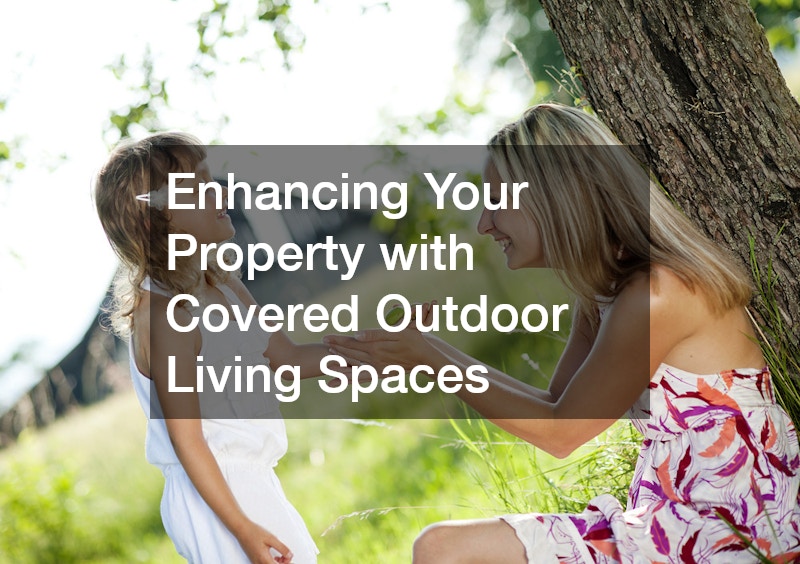Introduction
The trend of enhancing outdoor living spaces has gained significant momentum in recent years. Homeowners are seeking ways to extend their indoor comforts into the outdoors, making their yards more versatile and functional. Covered outdoor living spaces offer a perfect solution, providing protection from the elements while maintaining an open-air feel. Whether it’s for relaxation, dining, or entertaining guests, covered spaces allow you to enjoy the beauty of your yard throughout the year, regardless of weather conditions.
Not only do these spaces boost your quality of life by encouraging more time spent outdoors, but they also add significant value to your property. A well-designed outdoor living space enhances both the aesthetic appeal and the resale value of a home, making it a smart investment for any homeowner. Furthermore, many homeowners are exploring how to convert garages into outdoor living spaces, adding even more versatility to their homes. This guide will walk you through various types of covered outdoor spaces, design ideas, materials to consider, and maintenance tips to ensure that your outdoor area remains beautiful and functional for years to come.
Types of Covered Outdoor Living Spaces
When deciding to add a covered outdoor space to your home, you have several design options, each offering its own benefits. The most common types include pergolas, gazebos, and retractable awnings, each providing varying degrees of shade and shelter.
Pergolas
Pergolas are among the most popular choices for outdoor spaces. These structures consist of vertical posts that support a lattice of beams and rafters, creating an open framework that can be left bare or adorned with climbing plants like ivy or wisteria. Pergolas provide partial shade, allowing sunlight to filter through while still offering some protection from direct sunlight.
One of the major advantages of pergolas is their versatility. You can customize them to suit your aesthetic preferences and the layout of your yard. Additionally, pergolas create an intimate, elegant ambiance, making them ideal for spaces dedicated to relaxation or casual social gatherings.
Gazebos
For those who prefer more shelter, gazebos offer a more enclosed option. These freestanding structures feature a solid roof and open sides, providing excellent protection from both sun and rain. Gazebos can serve as a focal point in your yard and are perfect for creating a distinct area dedicated to recreation, dining, or simply unwinding.
Gazebos offer a more permanent solution and often come in a range of sizes and styles. Whether it’s a small reading nook or a large entertainment area, a gazebo adds both functionality and charm to your outdoor space.
Retractable Awnings
If flexibility is what you’re after, retractable awnings are an excellent choice. These can be extended or retracted as needed, providing shade and shelter when desired and allowing for open-air enjoyment when the weather is pleasant. Awnings can be installed over patios, decks, or windows, giving you control over your outdoor environment.
Retractable awnings are particularly useful in climates where weather conditions can change quickly. They provide shade during the heat of the day and can be rolled back to enjoy the evening breeze or starlit sky.
Converting Your Garage to Outdoor Living Space
An increasingly popular trend for homeowners is to convert a garage to outdoor living space. By transforming this often-overlooked area of the home, you can add a whole new dimension to your property’s functionality and aesthetics. Garages typically offer a large, underutilized space that can be repurposed into a sheltered outdoor room for dining, lounging, or entertaining.
Benefits of Garage Conversion
Converting a garage into an outdoor living space has multiple advantages. First, it allows you to maximize your existing property space without the need for extensive construction. Second, since garages typically have solid structures and some degree of shelter already, the cost and effort of transformation can be significantly lower compared to building a new outdoor space from scratch.
Design Ideas for Garage Conversions
The process to convert a garage to outdoor living space involves making aesthetic and functional adjustments. One option is to replace the garage door with large glass sliding doors or bifold doors, allowing for more natural light and an open flow between the indoor and outdoor areas. Adding a pergola or retractable awning can extend the covered area, providing a seamless transition between your newly converted garage and the rest of your outdoor space.
Incorporating elements like built-in seating, an outdoor kitchen, or even a fire pit can elevate the utility of your converted garage. Think about weatherproofing and ventilation to ensure the space is comfortable year-round.
Design Ideas for Covered Outdoor Spaces
Creating a functional and visually appealing outdoor living space requires careful planning. Below are some design ideas to help you transform your backyard or garage into a sanctuary of comfort and style.
Outdoor Kitchens
One of the hottest trends in outdoor living is the outdoor kitchen. Imagine preparing meals outdoors, protected from sudden weather changes by a stylish roof or awning. With modern conveniences like running water, refrigerators, and cooking appliances, outdoor kitchens make it easy to entertain guests or enjoy a family meal in the fresh air.
An outdoor kitchen can range from a simple grill station to a fully equipped space with everything needed for gourmet cooking. Covered outdoor kitchens also allow you to cook comfortably, even in less-than-ideal weather conditions, expanding the use of your yard.
Cozy Seating Areas with Fire Pits
Adding a fire pit to your covered outdoor space is a great way to create a warm, inviting atmosphere. Fire pits extend the usability of your space into cooler months, allowing you to enjoy the outdoors even during chilly evenings. Cozy seating around the fire pit can turn any gathering into a relaxing retreat.
Consider incorporating plush seating, side tables, and soft lighting to enhance the ambiance. Fire pits also serve as a focal point, making your covered outdoor area the perfect spot for intimate conversations or gatherings with family and friends.
Dining Areas
Transform your backyard into an alfresco dining experience with a covered outdoor dining area. Whether it’s a formal dining set or a more casual arrangement, adding a cover ensures that you can enjoy meals outdoors regardless of the weather. Outdoor dining spaces are perfect for hosting summer barbecues, family dinners, or quiet breakfasts while enjoying the beauty of nature.
Adding elements such as string lights, pendant lighting, or ceiling fans can make your outdoor dining area more comfortable and appealing. In colder months, outdoor heaters can extend the use of this space.
Materials to Consider for Covered Outdoor Spaces
Choosing the right materials is crucial to creating a durable and aesthetically pleasing outdoor space. The following are some of the most popular materials used in constructing covered outdoor living areas.
Wood
Wood is a classic and versatile material that blends beautifully with natural landscapes. It provides a warm, inviting look and can be stained or painted to match your home’s exterior. However, wood requires regular maintenance to prevent rot, decay, and insect damage. Periodic sealing or painting is necessary to keep it looking fresh and to protect it from the elements.
Aluminum and Vinyl
Aluminum and vinyl are low-maintenance, durable alternatives to wood. These materials are resistant to weather, rot, and pests, making them ideal for homeowners who want a long-lasting, low-maintenance structure. Aluminum is particularly lightweight and strong, making it suitable for modern, sleek designs, while vinyl offers a clean, classic look that requires little upkeep.
Composite Materials
Composite materials offer the best of both worlds, combining the beauty of wood with the durability of synthetic materials. Composites are designed to withstand harsh weather conditions and require minimal maintenance. They are also environmentally friendly, as they are often made from recycled materials. For homeowners looking for a balance between aesthetics and durability, composites are an excellent choice.
How to Maintain Your Covered Outdoor Space
To ensure that your covered outdoor space remains functional and attractive, regular maintenance is essential. Each type of material requires different maintenance techniques, and it’s important to understand how to care for your space to prevent damage and extend its lifespan.
Regular Cleaning
Dirt, debris, and moisture can accumulate on your outdoor structure over time, leading to discoloration or damage. Regular cleaning is crucial to maintaining the appearance and integrity of your covered space. Wooden structures should be cleaned with a mild detergent and resealed annually to prevent weather damage, while aluminum and vinyl can be cleaned with soap and water.
Weather Protection
The elements can take a toll on any outdoor space, especially in areas with harsh climates. Using weather-resistant materials, such as treated wood or composite decking, can significantly reduce the wear and tear caused by sun, rain, and wind. Additionally, installing protective covers or curtains during storms or extreme weather conditions can help shield your outdoor area and reduce maintenance efforts.
Maximizing Usability in All Seasons
A well-designed covered outdoor space can be enjoyed year-round with a few adjustments to accommodate different seasons. Here’s how to ensure your outdoor living area remains functional no matter the weather.
Winter
During the colder months, adding outdoor heaters or a fireplace can make your covered space inviting and cozy. Consider using outdoor furniture made from weather-resistant materials like metal, wicker, or teak, and protect cushions and fabrics with waterproof covers. Roll-up screens or curtains can also be installed to block cold winds and retain warmth.
Summer
During the summer, it’s important to have adequate shade and cooling mechanisms in place. Ceiling fans or portable misting systems can help keep your outdoor area cool and comfortable. Additionally, planting trees or tall shrubs around your outdoor space can provide natural shade and enhance the overall aesthetic of your yard.
How Covered Outdoor Spaces Enhance Property Value
Adding a covered outdoor living space is not just about creating an enjoyable environment; it’s also a smart investment that can significantly boost your home’s value. Outdoor spaces are increasingly in demand, and having a well-designed, functional area can make your property more attractive to potential buyers.
Covered spaces, such as pergolas, gazebos, and awnings, add square footage to your home’s usable area.and expand your livable space, making it an enticing feature for potential homebuyers. Buyers are drawn to the idea of outdoor living areas where they can entertain guests, enjoy family time, or simply relax in the open air without worrying about the weather. This is especially true in regions with mild climates, where outdoor living spaces can be used year-round.
When considering selling your home, a thoughtfully designed and well-maintained outdoor living area can set your property apart from others on the market. The investment in such a space can yield a high return, particularly when the area is aesthetically pleasing and functional. Adding a convert garage to outdoor living space concept into your overall property design further boosts appeal by showing how you’ve maximized every square foot of the property.
Conclusion
Whether you are looking to enhance your own enjoyment of your home or add value for a future sale, investing in a covered outdoor living space is a decision that will pay off. From cozy seating areas with fire pits to full outdoor kitchens and converted garage spaces, there are countless ways to tailor your outdoor area to suit your lifestyle. Thoughtful design, careful material selection, and regular maintenance will ensure that your outdoor space remains a cherished part of your home for years to come.
By planning with both form and function in mind, your covered outdoor living space can become the heart of your home—an area where you can relax, entertain, and connect with the natural world, regardless of the weather outside.


